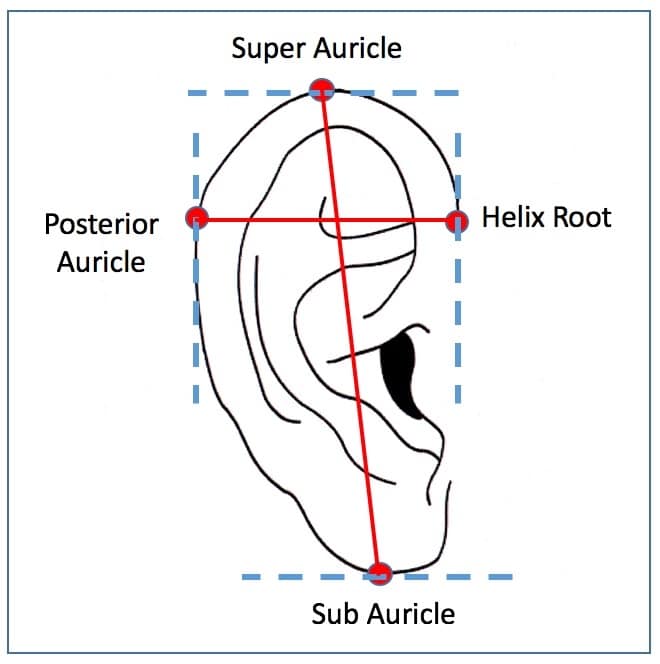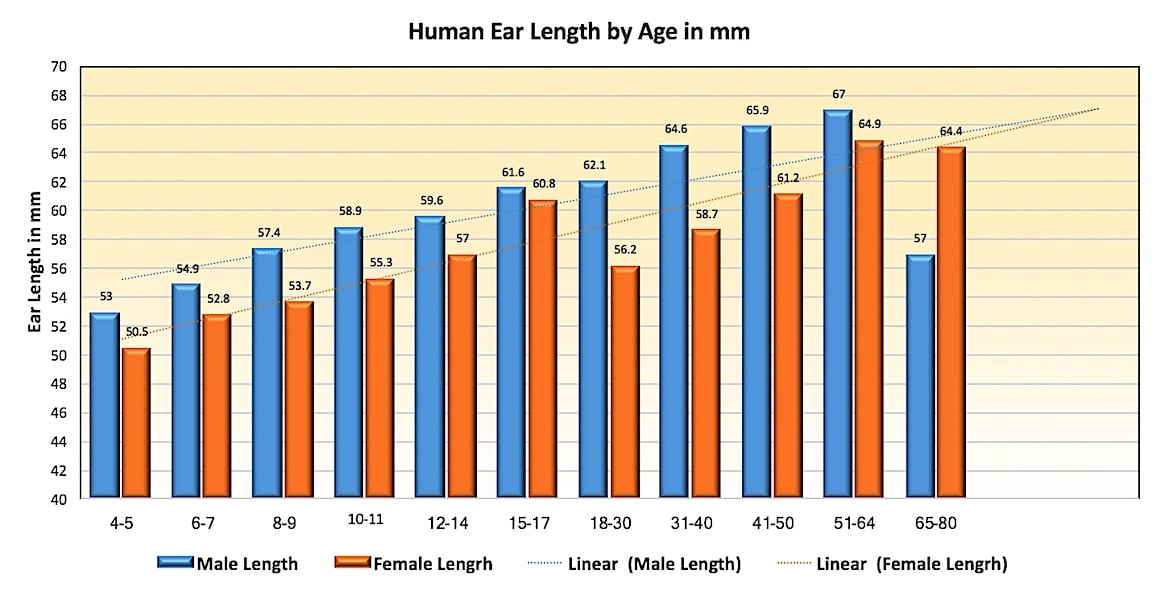This post is a third in a series related to the anatomy of the human ear, specifically of the pinna, or auricle. Part 1 of this series started by identifying and defining the main external structural features of the auricle. Part 2 concentrated on two primary dimensions of the auricle – length and width, but looked at these dimensions primarily for ages of about 17 to 30. This post provides information about the differences in the auricle length and width between males and females covering a range from 4 to 80 years of age.

Figure 1. Auricle length is measured from the most superior to the most inferior projection. Both are based on using a horizontal line as the basis for the measurement. Auricle width is measured from the most posterior extension of the auricle to the root of the helix, where the auricle and scalp meet. Both these measurements are based using the vertical lines, as shown.
Perhaps the greatest population of such age-related data has been provided by Sforza and colleagues in a study conducted in Italy1. Even though length and width appear to have different dimensions relative to ethnicity, the age data provided here might be considered to have similar trends, not measurements, among other ethnic groups. Measurements that follow were gathered using the dimensions of Figure 1.
Auricle Length Differences by Age
Figure 2 provides human ear length differences as a function of chronological age. A caveat is that not all age groups had the same number of subjects, so this should be taken into consideration. For reference purposes, the number of subjects in each age group is provided in Table I. The linear forecasts seem to suggest that while the auricle length increases with age, that the difference is not as great between the genders as age increases.

Figure 2. Human ear length by age for males (blue) and females (orange). Right and left ear measurements are combined. The dotted lines represent a linear forecast. (Data has been adapted, redrawn, and forecast based on Sforza et al.1).
Auricle Width Differences by Age
Figure 3 provides human ear width differences as a function of chronological age. Again, because not all age groups had the same number of subjects, this should be taken into consideration. The number in each group is the same as in Table I. Linear forecasting shows that the average auricle width increases with age, along with a slight increase between the genders as well.

Figure 3. Human ear width by age for males (blue) and females (orange). Right and left ear measurements are combined. The dotted lines represent a linear forecast. (Data has been adapted, redrawn, and forecast based on Sforza et al.)1
General Comments
Some studies attribute auricle length to changes primarily in the lobule. This post is not interested in lobule length and width separately, as are some studies, primarily because the lobule is not generally involved in the placement of components into the ear concha and its cartilaginous framework. Aside from this, following are some general comments related to the auricle length and width:
- Relative to the 18-30-year age groups:
4-5 year-olds have an auricle length of approximately 14% shorter
65-80-year olds have an auricle length of approximately 19% longer
- Ear length increased more than ear width with age
- The ear width-to-length ratios were larger in the lower age groups
- The human auricle continues to grow well beyond the attainment of skeletal maturity
- The microscopic structure of ear cartilage has been reported to show reductions in elastic fibers and in the density of cartilage cells2,3
- Boys and men have larger ears than girls and women
- Between ages 12 and 14, both ear length and width have attained adult values in females, but adolescent growth in males is not yet finished
- Normal lobule clearly changes from a short and wide structure in youth to one that is long and narrow
References
- Sforza C, Grandi G, Binelli M, Tommasi DG, Rosati R, Ferrario VF. (2009). Age- and sex-related changes in the normal human ear. Forensic Sci. Int. 187 (1): 110.e1-7.
- Meijerman L, van der Lugt C, Maat GJR. (2007). Cross-sectional anthropometric study of the external ear. Forensic Science 52:286-293.
- Purkait R, Singh P. (2007). Anthropometry of the normal human auricle: a study of adult Indian men. Aesthetic Plastic Surgery 31 (4):371-379.








Perhaps the gap between the mean ear lengths for older men and older women are influenced by the weight of large and decorative earring wear over a lifetime. This gendered cultural practice can often lengthen the lobule with the respect to the rest of the ear over time.
That’s correct, and gay men also wear decorative ear gear that can warp the shape of the lower pinna. Transgenders are also moving in to decorate their ears too !
Various studies comment on this, but when populations are taken into consideration where such decorative ear features are worn, statistical analysis results are not statistically significant. Still, I would be somewhat inclined to agree with you.